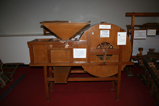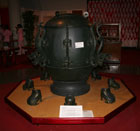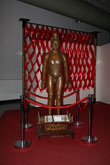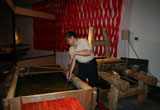Contrary to popular belief, scientist Alfred Nobel didn’t invent gunpowder, instead he invented dynamite. And no, neither was gunpowder invented by those masked creatures/people you saw flinging bombs at the Spartans in Frank Miller’s epic graphic novel/movie, 300.
However you’ll have to go to the Singapore Science Centre’s newest exhibition, “China: 7000 Years of Innovation”, from May 26 to Aug 26 to uncover the truth.
The exhibition, which contains artefacts worth more than $1 million, according to the organisers at the Singapore Science Centre, “will showcase scientific discoveries and technological inventions [from China] that spans from astronomy to papermaking”.
 Dr Chew Tuan Chiong, Chief Executive of the Singapore Science Centre, shed some light on what the exhibition will hold when he revealed that the 30 exhibits will include “the famous ‘4 Great Inventions’-the compass, gunpowder, paper and the printing press-starting 7,000 years ago.”
Dr Chew Tuan Chiong, Chief Executive of the Singapore Science Centre, shed some light on what the exhibition will hold when he revealed that the 30 exhibits will include “the famous ‘4 Great Inventions’-the compass, gunpowder, paper and the printing press-starting 7,000 years ago.”
He added that Singapore’s geographical position at the tip of the Malaysian Peninsula also means that we are “at the crossroads of East and West” cultures thus providing the perfect opportunity to offer a balanced view to suit both sides of the coin.
And in case you’re about to dismiss the impact of the 4 great inventions, try imagining life without toilet paper, maps, fireworks (the kind used in the annual National Day Parade) and newspapers. Is it utterly incomprehensible for you?
Another interesting component of the exhibition that might interest health nuts or non-health nuts alike is most likely be the Traditional Chinese Medicine (TCM) section, which accounts for 15 percent of the total floor space used at the exhibition.
 The TCM exhibits will showcase medical practice that, though uncommon to many Singaporeans, has had a far more illustrious history spanning more than 5,000 years, compared to their more popular Western counterparts.
The TCM exhibits will showcase medical practice that, though uncommon to many Singaporeans, has had a far more illustrious history spanning more than 5,000 years, compared to their more popular Western counterparts.
This segment of the exhibition will shed some light on this practice that seems to be regaining the interesting of both the scientific world and laymen alike.
Dr Chew explained, “In covering the cultural wealth and the scope of TCM, through history and into modernity, visitors will see how TCM has always promoted the well being of the various populations into which it has been accepted. We hope to use this exhibition as a platform to provide a balanced scientific view on the subject.”
 Given exhibits like the “Fur on the Tongue”, which will allow visitors to figure out how physicians back then managed to diagnose their patients based on their tongues and coatings, or the “Copper Acupuncture Figure” with its 354 miniature holes to represent the acupuncture points of the human body, visitors will undoubtedly be enthralled with what they can see and experience at the Singapore Science Centre.
Given exhibits like the “Fur on the Tongue”, which will allow visitors to figure out how physicians back then managed to diagnose their patients based on their tongues and coatings, or the “Copper Acupuncture Figure” with its 354 miniature holes to represent the acupuncture points of the human body, visitors will undoubtedly be enthralled with what they can see and experience at the Singapore Science Centre.
And the exhibition doesn’t just end there. According to the organisers, there will also be “a series of educational programmes” offered to the general public which include “the likes of papermaking, compass constructing, and the building of earthquake detector”.
Sad to say however, that due to safety concerns, visitors to the exhibition won’t be allowed to participate in any gunpowder demonstrations.
General Information:
Name: China: 7000 Years of Innovation
Date: 26 May -26 Aug
Opening Hours: Tuesdays – Sundays, 10am – 6pm (Closed on Mondays except School & Public Holidays)
Address: The Annexe, Singapore Science Centre Road Ticket
Prices: $9 (Adult), $7 (Child), $30 (Family Package, 2 Adults & 2 Children) (Best Value Package: Ticket includes entry to Singapore Science Centre)
Enquiries: 6425-2500
For more information on China: 7000 Years of Innovation, visit the Singapore Science Centre’s official website.

